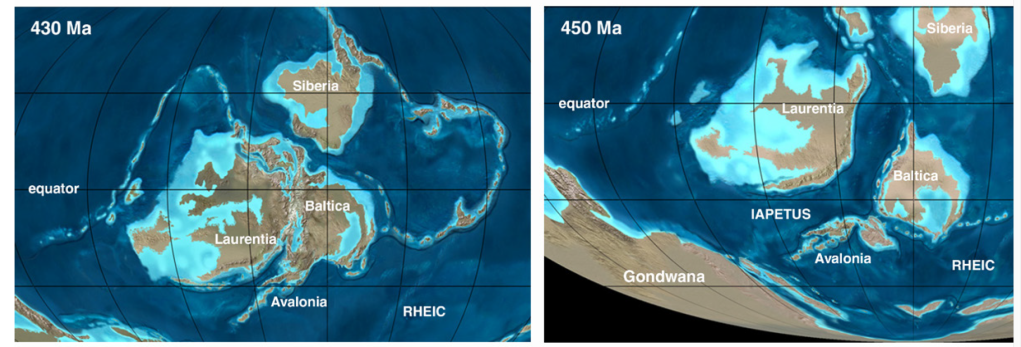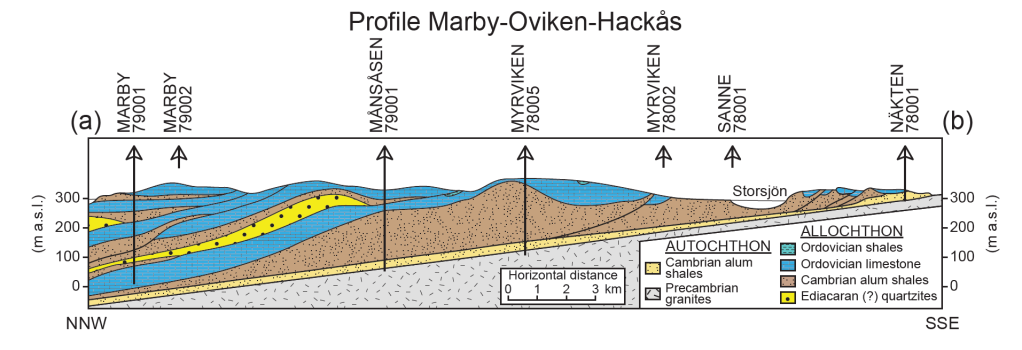What we today know as Alum shale was originally an organic-rich clay that was deposited in a shallow ocean off the coast of the old continent Baltica. Although this deposition took place between 513 to 480 million years ago during the middle and upper Cambrian and the early part of the Ordovician, it is nonetheless of importance today. The very special depositional environment led to that the Alum shale is very rich in metals and minerals, among others molybdenum, vanadium and uranium. The high amounts of a range of different metals and minerals make the Alum shale an important resource.

Remains of Alum shale can today be found in many parts of Sweden: in Skåne, Öland, Gotland, Närke, Östergötland, Jämtland and Härjedalen. The shale may lay close to the surface or is covered by rocks of younger age and or glacial sediments. It can also have a considerable thickness of several hundred meters. What is common to the Alum shale in all areas is that it very fissile, that it weathers easily and breaks up into smaller and smaller flakes. During physical and chemical weathering toxic elements, among these uranium, are released into soils and groundwater. I have written about this process in my earlier blogs: https://barbarawohlfarth.wordpress.com/2019/09/02/leakage/ and also https://barbarawohlfarth.wordpress.com/2019/06/28/history-is-talking/
During the millions of years of geological history, southern Sweden experienced a different development as compared to for example Jämtland. In contrast to southern Sweden, Jämtland was much stronger influenced by tectonic processes during the formation of the Scandes Mountain belt some 490 to 390 million years ago, when the former continents of Baltica and Laurentia collided with each other.

In Jämtland, Cambrian and Ordovician rocks were thrust and partly folded, whereas rocks in southern Sweden ‘only’ experienced some squeezing and dislocation. The faulting and thrusting of Cambrian and Ordovician Alum shale and limestone resulted in a complicated picture with repeated stacking of the original horizontally deposited layers. The picture below is an illustration of how Alum shale and limestone are stacked upon each other in the Oviken/Myrviken area of Jämtland.

at a vertical exaggeration of 10 : 1. doi:10.5194/se-7-769-2016
The figure above shows a geological transect. It is based on interpreting the succession of rocks (stratigraphy) encountered in 28 drill holes (marked by arrows in the figure above). The configuration of the layers and the stratigraphy between the coring points is either inferred or supported by outcrops. These 28 drill holes (or bore holes) had been made by the Swedish Geological Survey (SGU) between 1977 and 1979 to investigate the metals contained in the Alum shale. The extensive survey by SGU in and around Myrviken allowed identifying a 180 m thick Alum shale deposit that contains low-grade uranium, vanadium, molybdenum and nickel (Juhlin et al. 2016).
The SGU study also highlights that the geology in the area is complicated, because of the tectonic processes that took place some 490 to 390 million years ago. These processes dislocated huge piles of rock layers and stacked them upon each other, as can be seen in the Figure above. Without the forces of tectonics, the succession of rock layers in Jämtland would look pretty similar to that in Skåne and would broadly encompass: Precambrian basement, Cambrian sandstone/quartzites, Cambrian Alum shales, lower Ordovician Alum shale, Ordovician limestone, and so on. But given Jämtland’s geological history, the situation is more complicated.


Pingback: Where is the vanadium in Jämtland? | Barbara Wohlfarth